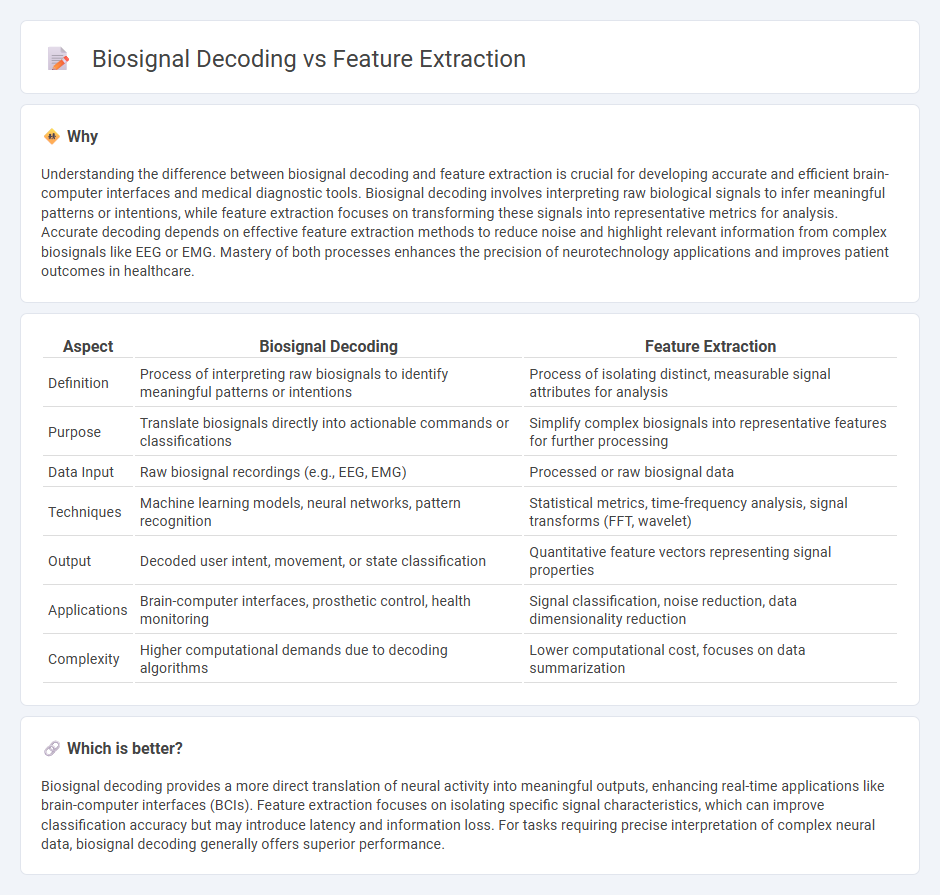
Biosignal decoding involves interpreting raw physiological data to identify meaningful patterns or states, while feature extraction focuses on selecting specific characteristics from signals to simplify analysis and improve accuracy. Decoding translates complex biosignals like EEG, ECG, or EMG into actionable insights, whereas feature extraction reduces dimensionality by isolating relevant signal components such as frequency bands or amplitude variations. Explore advanced techniques and applications in biosignal processing to enhance biomedical and AI innovations.
Why it is important
Understanding the difference between biosignal decoding and feature extraction is crucial for developing accurate and efficient brain-computer interfaces and medical diagnostic tools. Biosignal decoding involves interpreting raw biological signals to infer meaningful patterns or intentions, while feature extraction focuses on transforming these signals into representative metrics for analysis. Accurate decoding depends on effective feature extraction methods to reduce noise and highlight relevant information from complex biosignals like EEG or EMG. Mastery of both processes enhances the precision of neurotechnology applications and improves patient outcomes in healthcare.
Comparison Table
| Aspect | Biosignal Decoding | Feature Extraction |
|---|---|---|
| Definition | Process of interpreting raw biosignals to identify meaningful patterns or intentions | Process of isolating distinct, measurable signal attributes for analysis |
| Purpose | Translate biosignals directly into actionable commands or classifications | Simplify complex biosignals into representative features for further processing |
| Data Input | Raw biosignal recordings (e.g., EEG, EMG) | Processed or raw biosignal data |
| Techniques | Machine learning models, neural networks, pattern recognition | Statistical metrics, time-frequency analysis, signal transforms (FFT, wavelet) |
| Output | Decoded user intent, movement, or state classification | Quantitative feature vectors representing signal properties |
| Applications | Brain-computer interfaces, prosthetic control, health monitoring | Signal classification, noise reduction, data dimensionality reduction |
| Complexity | Higher computational demands due to decoding algorithms | Lower computational cost, focuses on data summarization |
Which is better?
Biosignal decoding provides a more direct translation of neural activity into meaningful outputs, enhancing real-time applications like brain-computer interfaces (BCIs). Feature extraction focuses on isolating specific signal characteristics, which can improve classification accuracy but may introduce latency and information loss. For tasks requiring precise interpretation of complex neural data, biosignal decoding generally offers superior performance.
Connection
Biosignal decoding involves interpreting raw biological data from sensors, while feature extraction focuses on isolating relevant patterns and characteristics within these signals to improve accuracy. Efficient feature extraction enhances the performance of decoding algorithms by highlighting essential biosignal components such as EEG frequencies or ECG waveforms. Together, they enable precise analysis and real-time applications in healthcare, brain-computer interfaces, and wearable technology.
Key Terms
Dimensionality Reduction
Feature extraction simplifies high-dimensional biosignals by selecting relevant variables, while biosignal decoding interprets these features to understand physiological states or intentions. Dimensionality reduction techniques such as Principal Component Analysis (PCA) and t-Distributed Stochastic Neighbor Embedding (t-SNE) play a crucial role in enhancing decoding accuracy by minimizing noise and redundant information. Explore advanced dimensionality reduction methods to improve the efficiency and precision of biosignal analysis.
Signal Processing
Feature extraction involves isolating essential characteristics from raw biosignals such as EEG, ECG, or EMG, using techniques like wavelet transform, Fourier analysis, and principal component analysis to enhance signal clarity and reduce dimensionality. Biosignal decoding translates these extracted features into meaningful information or control commands by employing machine learning algorithms, neural networks, or classifiers to interpret physiological states or intentions. Explore advanced methods and applications in biosignal processing to deepen your understanding of this critical domain.
Neural Networks
Feature extraction involves isolating specific, informative signal attributes from raw biosignals, enhancing the input representation for neural networks used in biosignal decoding. Neural networks decode biosignals by learning complex mappings between these features and target outputs, enabling accurate interpretation of brain activity or physiological states. Explore more about how neural networks optimize feature extraction for advanced biosignal decoding applications.
Source and External Links
What is Feature Extraction? Feature Extraction Techniques ... - Feature extraction in machine learning is the process of identifying and extracting relevant features from raw data using techniques like autoencoders and principal component analysis to reduce dimensionality and capture essential information.
What Is Feature Extraction? | IBM - Feature extraction is a dimensionality reduction technique that simplifies raw data into a structured format emphasizing the most relevant variables to improve machine learning model efficiency and performance.
Feature Extraction in Machine Learning: A Complete Guide - Feature extraction transforms raw data into meaningful features via manual engineering or automated methods, enhancing data representation and model accuracy in machine learning.
 dowidth.com
dowidth.com